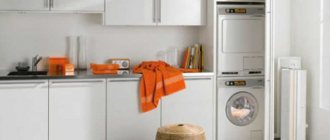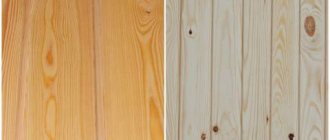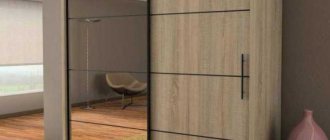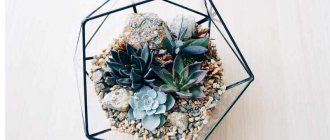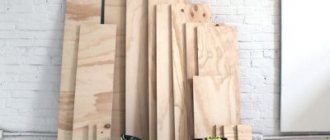A cabinet in the toilet is necessary for proper organization of space, for functional and aesthetic purposes. In small bathrooms it is most often installed behind the toilet, this way it will be possible to fill the area as comfortably as possible. In this article we will tell you what types of cabinets there are and give examples of real interiors.
Doors to the toilet for a plumbing cabinet - the 2 most common options
Louvered doors for sanitary cabinets
The biggest advantage of louvered toilet doors is that they are made of moisture-resistant plastic and PVC. It is the appearance that often raises doubts: it will not fit into every interior and not everyone will like it, however, for some design solutions it will be a very good choice.
If we consider this option from a practicality point of view, we must take into account that when opened, the blind system goes up. Access, of course, does not block, but the part of the door that gathers at the top goes into the mechanism, which takes up a significant space in the upper part of the opening. The lower part, made of this material, will require a large number of modifications.
Louvered doors can have an open top frame or a closed one built inside a niche
Well, there is one more significant drawback - the ability to install only in a completely finished opening. If the repairs in the toilet have not yet been completed, the walls have not been leveled, tiles have not been laid or wallpaper has not been pasted, then you should not install louvered doors in the toilet. otherwise, during installation there will be gaps that will need to be corrected.
Unusually shaped shelves
Storage shelves in the toilet.
READ MORE: Choosing rhombic jacks with a load of 2 tons
The size of the room is not an obstacle to experimenting with design. Even the interior of a small room can be advantageously diluted with unusual objects. Install not just open shelves, but furniture of an unusual shape, for example, in the form of a honeycomb.
Honeycomb-shaped shelves in the toilet.
Plastic doors for sanitary cabinets
Plastic doors for a toilet cabinet are the easiest to install and, importantly, will fit seamlessly into any interior. Another important advantage of plastic products is their moisture resistance and resistance to other types of influence.
Plastic doors come in a wide variety of designs, which allows you to choose a model for any style solution
A wide color palette provides plastic products with enviable popularity
Such doors are easy to clean; a simple damp cloth is enough, and in case of heavy contamination, you can use various cleaning agents without fear of harming the material.
Open shelves
Stylish storage in the toilet.
Open shelves can transform and complement any interior. They are especially relevant in tight spaces. Such storage systems do not clutter up the space, give a feeling of lightness, and can visually change the interior for the better. For example, in a cramped room they should be installed on a narrow wall, this way you can visually stretch it out, thereby expanding the space.
Homemade storage system in the toilet.
Neat open shelves in the toilet.
Open shelves in the toilet.
Storage in the toilet on open shelves.
Storage in a small closet.
Stylish design of a small toilet.
Types of door configurations for sanitary cabinets
There are a lot of options for what doors can be. You can consider various materials for manufacturing: drywall, plywood, wood, chipboard, tile, mirror and so on. Each of these options has both its advantages and disadvantages.
Hinged doors made of natural wood coated with clear varnish
Double door wardrobe with laminated chipboard doors
According to the type of configuration, you can also choose from a variety of options: standard doors with a traditional opening method, shutters of the blind type, compartment doors, invisible doors or batten doors. It is the last two options that are used most often due to their convenience.
In the photo there are compartment doors made across the entire wall of the toilet
The photo shows a narrow hinged door made of frosted glass
Invisible door
Typically this option is used for painting or tiles. These designs have many advantages, because their design is as well thought out as possible. They close well (tightly), and at the same time allow easy access to meters and other communications.
Such a door is practically invisible and does not attract attention in the interior, because its outlines merge with the tile seams. They have many options for decoration: it can be marble, mirrors, artificial or natural stone. A special mechanism allows you to open the hatch using a pressing motion. The installation must be carried out at the same time as the installation of the cabinet walls, after which it, together with the walls of the room, is lined.
It is better to entrust the installation of such a structure to professionals, since the installation process has many nuances.
Doors with lathing
This option is quite simple and convenient, and it will not cost much at all. Doors with lathing are suitable for any plumbing cabinet. The main thing is to take measurements in advance and purchase the appropriate furniture. Typically, the material for making such doors is wood or PVC. They are easy to install, but you need to prepare the frame block, fastening the hinges and the lock in advance. If the doors are made of wood, take care to cover them with varnish or stain. Plastic specimens do not require additional processing.
Doors with bars provide ventilation to the cabinet and help create a neat interior
The structure of the lathing allows for good ventilation inside the cabinet, but significantly reduces sound insulation.
The photo shows lattice doors covering the boiler for heating water.
Drawing a diagram
Before you make a cabinet behind the toilet in the toilet with your own hands, you need to make a competent diagram.
Drawing up a diagram is a necessary step before starting work.
The main points to pay attention to when drawing are listed below.
- Draw the diagram in standard planes (top view, side view, profile view).
- Apply dimensions indicating allowances. An extra 2-3 mm will not make a difference when cutting MDF sheets. Not such a big expense. But when cutting, there is a gap at the cutting site, which is why the geometric parameters of the lined workpiece will differ. To eliminate this discrepancy, the allowance must correspond to the size of the gap from the cut.
- When installing a cabinet with closed doors, draw out the interior arrangement on a separate sheet. This way you can competently plan the internal space and cut workpieces according to pre-specified parameters.
- Separately, draw a diagram for cutting blanks and parts. This will save you money on buying extra material. Proper planning of expenses is the basis.
- Mark all necessary junctions of pipelines, electrical wiring, and sockets. On the cutting sheet, be sure to mark on which side you plan to cut the recess for the pipe. This will allow for better distribution of the material.
It is advisable to make the diagram as detailed as possible.
Draw a sketch separately. For a more effective presentation, use colored pencils, markers or paint. Organize your design at the highest level. Consider several options for the future decoration of the restroom. This will allow you to choose the optimal design.
Choosing a color scheme
Traditionally, neutral shades close to pastel colors are preferred in the bathroom and toilet. However, modern materials allow you to choose absolutely any color scheme. The plumbing cabinet in the toilet must comply with the same rules.
Light plastic doors, successfully matched to the color of the ceramic tiles
Dark doors in contrast to the finish of the plumbing unit
The main thing is not to forget about the rules of combination when choosing shades for your design:
- Combine warm shades with warm, cold with cold.
- Use 1 main color and 2-3 shades of it.
- Maintain balance in color combinations. If you choose bright colors, balance them with discreet elements.
- To avoid making a mistake when choosing a color scheme, use the color combination table.
The technique of combining contrasting colors is relevant. In a light-colored toilet, doors can become a bright accent. Or, on the contrary, to decorate the doors you can use the same color scheme as in the entire toilet, so as not to attract attention to the cabinet and make it invisible.
Louvered swing doors with beige tiles
Plasterboard shelves
Drywall is a universal material that allows you to create entire niches with shelves. You can make rounded shapes or corner designs. To form a frame, which will then be sheathed with sheets of plasterboard, a metal profile is used. It will not be difficult to assemble such a structure with your own hands. In the photo, the shelves in the toilet are made of plasterboard and painted with white paint.
The first step is to draw up a detailed project for the future design of the shelves. Using a profile, we build a frame. The joints of the profiles are secured using special staples. We cut the drywall and attach it to the frame.
The next stage will be finishing the product. We level the surface of the niche itself and the shelves using putty. Use a silicone spatula to distribute the mixture. We are waiting for the putty to dry completely. Next, carefully sand the surface of the shelves with fine-grained sandpaper. You should get perfectly even shelves.
How to change the design of a bathroom using stylish doors for a sanitary cabinet
Indeed, such an inconspicuous interior element as a cabinet in the toilet can radically change the space of the room. Make it not only stylish, but also more spacious, aesthetic and functional.
When choosing the design of a sanitary cabinet, it is important to take into account the style of the interior
To change the design of your bathroom as successfully as possible using stylish sanitary doors to the toilet, follow the advice of professionals in the field of renovation and design:
- The deepest possible design will significantly save space in the bathroom or toilet.
- For the most durable use, choose moisture-resistant materials with high strength and resistance to external factors of mechanical and physical influence.
- Access to the pipeline, boiler, risers and communications should not be difficult.
- Install a ventilation grille above the cabinet to remove excess moisture. This will extend the life of the product.
Methods for installing various structures and the necessary tools
Usually in a bathroom there is a vertical sewer riser in the bathroom or toilet and water supply running through the ceiling and floor slabs. Therefore, the way to hide the pipes must provide coverage of some area from the ceiling to the floor, including the walls.
The finishing should not be too voluminous (brickwork, gas silicate blocks), because the space in the bathrooms is very limited, so thin-walled materials are chosen, the fastening of which is carried out along the entire perimeter of the ceiling.
For fastening finishing building materials, wooden beams and metal profiles for drywall are most often used. To mount it, dowels with screws are used, for which holes are drilled in concrete or brickwork. To perform these operations, you will need a household electric drill with an impact vibration function or a hammer drill. To screw sheets to a metal profile, it is useful to have a screwdriver and a grinder will never hurt.
Fig.2 Tiled wall in the toilet
Selection criteria and advantages of various materials
When determining how to hide pipes in the toilet, the main attention is paid to the finishing material, which should have the following properties:
- Aesthetics. The material must be combined with the decoration and interior of the toilet room.
- Strength. To access ball valves and water metering devices, hatches are installed; the structure of the selected material must hold them securely.
- Moisture resistance. Any room with plumbing equipment has high humidity, so finishing materials should not be afraid of moisture.
Drywall
The above requirements are fully satisfied by plasterboard having the following performance properties:
- It is easy to install and dismantle without the use of special tools; it is easy to embed plumbing hatches into drywall.
- It is an environmentally friendly substance, non-flammable, moisture-resistant types are not afraid of moisture.
- The main advantage of drywall is the possibility of further finishing with tiles, which in the vast majority of cases are used in toilets. It should be taken into account that after gluing the tiles, if necessary, to gain access behind the wall, you will have to dismantle all its elements.
Fig.3 Finishing the bathroom with plastic panels
Plastic panels
The second most popular type of finish used to hide pipes is PVC panels with the following properties:
- Low cost - PVC panels are the most budget-friendly finishing option.
- They are easily mounted on a frame made of metal profiles or wooden beams; if necessary, the back wall in the toilet can be easily removed to access communications.
- They are light in weight and have sufficient strength to install lightweight plastic hatches without additional reinforcement of the walls.
- The panels are moisture resistant, easy to maintain, and do not contribute to the formation of mold and mildew.
- They have an aesthetic appearance and a wide selection of colors and patterns.
Original blinds
The use of horizontal blinds is a less common and original way of covering surfaces in niches with communications. When installing them, it should be taken into account that the sewer pipe below and the hose supplying water to the toilet will prevent them from completely lowering, so you will have to make a box with a flat horizontal surface for the pipes. Horizontal blinds are made from aluminum plates or bamboo (bamboo is not a good option for a humid environment), they are best suited for small washrooms and have the following performance properties:
- The main advantage of blinds is their low cost.
- An equally important advantage is the space saving - behind their surface in the area where communications are located, you can install shelves for household supplies.
- Metal blinds are not afraid of moisture, are environmentally friendly and easy to clean, their service life is almost unlimited.
- The blinds are easily mounted in one plane on the ceiling, without affecting the side walls.
The disadvantages of blinds include the presence of gaps between the side walls, not very high sound insulation and the need to install a ventilation hatch - in this case they will have to be hung below the ceiling, which will complicate the work.
Rice. 4 Blinds to cover pipes in the toilet
Photos of plumbing cabinets in the interior of the toilet
How to make it yourself
Almost any repair cannot be done without the help of specialists or other hired workers, however, there come times when the owner of the house decides to do something with his own hands. It is quite possible for even less experienced repairmen to make a plumbing cabinet with their own hands. Here are some useful tips:
- Depending on the layout of the room, you will need to install a built-in or wall-mounted plumbing cabinet. In the first case, there will be less consumption of materials and, possibly, less work;
- Having decided on the choice of design, it is worth building a frame. A metal frame is more durable than a wooden frame and is stronger. When installing the frame behind the toilet cistern, it is worth remembering that it will interfere with the opening of swing doors. The niche frame is a simple rectangle to which the door is attached;
- if the internal space allows you to organize storage in such a cabinet, then you need to install shelves on pre-attached horizontal metal corners. When installing shelves, it is very important that they do not touch the pipeline;
- The last stage of assembly is the installation of the selected facade.
It is important to remember to treat all parts with impregnation against moisture, and such a cabinet will last a very long time.



